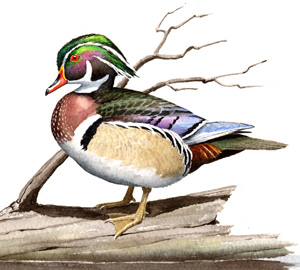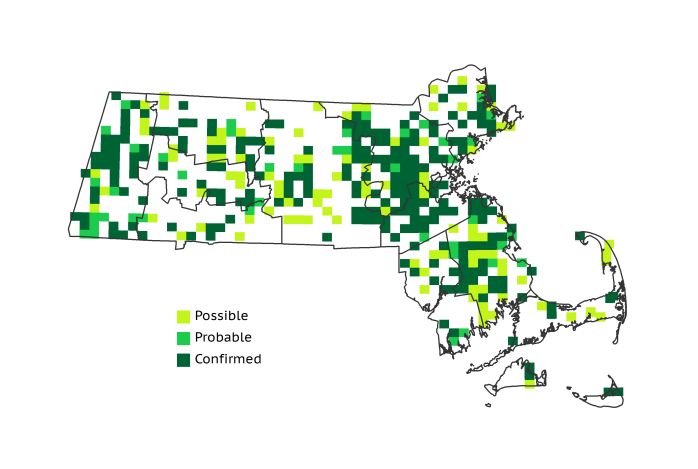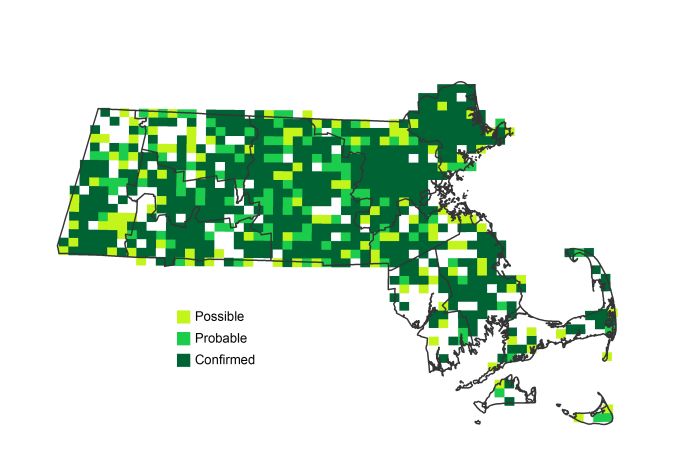Breeding Bird Atlases (BBA)
Find a Bird
Wood Duck
Aix sponsa

Very widespread and likely increasing
“The great beauty and neatness of their apparel, and the grace of their motions, always afford pleasure to the observer,…” – John James Audubon, Birds of America
Unlike most of our waterfowl, the aptly named Wood Duck nests in tree cavities. After the ducklings hatch, the hen coaxes them into leaping down from the nest into the water below, where they will follow behind her as they learn to forage and fend for themselves. Both hunting and loss of habitat have taken their toll on Massachusetts’ Wood Ducks in the past, but concern from both birders and the sporting community has been instrumental in helping one of our most striking waterfowl reclaim its place as a widespread breeding species in Massachusetts.
Historic Status
Wood Ducks join a long list of birds nearly extirpated from Massachusetts by market gunners in the late years of the nineteenth century. Gunpowder and shot were not their only enemies, however. The inexorable march of civilization over, around, and through the native forests in the seventeenth century removed many of the most suitable nesting trees preferred by this species. With the decline of farming in the twentieth century, forests gradually returned, as did cavities suitable for nesting. The protection afforded by the Migratory Bird Treaty Act of 1918 helped the population to grow as well, as did reintroduction of the beaver to Massachusetts in the 1930s. In more recent years, Wood Ducks received a helping hand from Massachusetts residents willing to support a statewide nestbox program in the 1950s. However, Wood Ducks sustained a hit from heavy pesticide usage after World War II, which caused food shortages for young wood ducks dependent on insects. The impacts of pesticides were responsible for a population dip that lasted into the 1970s (Petersen & Meservey 2003).
Atlas 1 Distribution
The lingering effects of overhunting and pesticides were still visible in the breeding footprint of Wood Ducks during Atlas 1. Wood Ducks were breeding in small numbers in the Taconic Mountains, and in just over 50% of the blocks in the Marble Valleys. The well-wooded Berkshire Transition and Berkshire Highlands zones had only scattered Wood Duck activity, however, and fewer than half of the blocks in the fertile Connecticut River Valley supported breeding Wood Ducks. The species’ distribution was most concentrated in eastern Massachusetts. Collectively, the Coastal Plains, Boston Basin, and Bristol/Narragansett Lowlands accounted for 53% of the state’s breeding Wood Duck blocks in Atlas 1. Wood Ducks bred thinly on the Cape and Islands, but the lack of large natural tree cavities in these areas largely excluded them from this ecoregion.
Atlas 2 Distribution and Change
During Atlas 2 Wood Ducks were found in almost 70% of the blocks statewide, and, while patchy in the southeast and the highest elevations in the west, they have apparently enjoyed a large-scale recovery. The Lower Berkshire Hills and Vermont Piedmont have had remarkable growth in their block occupancy rates and, along with the other ecoregions in the central part of the state, posted between 30% and 50% increases in blocks occupied by Wood Ducks. At the same time, the species has been remarkably persistent between the two Atlas periods, posting a loss from only 6% of the blocks they occupied during Atlas 1.
Atlas 1 Map

Atlas 2 Map

Atlas Change Map

Ecoregion Data
Atlas 1 | Atlas 2 | Change | ||||||
Ecoregion | # Blocks | % Blocks | % of Range | # Blocks | % Blocks | % of Range | Change in # Blocks | Change in % Blocks |
Taconic Mountains | 6 | 37.5 | 1.6 | 9 | 36.0 | 1.2 | 3 | 20.0 |
Marble Valleys/Housatonic Valley | 24 | 61.5 | 6.4 | 31 | 79.5 | 4.3 | 7 | 17.9 |
Berkshire Highlands | 21 | 38.2 | 5.6 | 38 | 69.1 | 5.3 | 15 | 28.3 |
Lower Berkshire Hills | 12 | 42.9 | 3.2 | 27 | 87.1 | 3.7 | 13 | 48.1 |
Vermont Piedmont | 3 | 17.6 | 0.8 | 11 | 64.7 | 1.5 | 4 | 33.3 |
Berkshire Transition | 7 | 18.4 | 1.9 | 29 | 72.5 | 4.0 | 14 | 45.2 |
Connecticut River Valley | 23 | 41.1 | 6.1 | 55 | 84.6 | 7.6 | 18 | 37.5 |
Worcester Plateau | 20 | 25.6 | 5.3 | 76 | 86.4 | 10.5 | 25 | 52.1 |
Lower Worcester Plateau | 32 | 43.2 | 8.5 | 67 | 83.8 | 9.3 | 21 | 38.9 |
S. New England Coastal Plains and Hills | 126 | 46.7 | 33.4 | 241 | 85.2 | 33.3 | 83 | 36.7 |
Boston Basin | 25 | 44.6 | 6.6 | 34 | 60.7 | 4.7 | 9 | 16.4 |
Bristol and Narragansett Lowlands | 50 | 47.2 | 13.3 | 56 | 49.1 | 7.7 | 4 | 4.0 |
Cape Cod and Islands | 28 | 20.6 | 7.4 | 49 | 34.0 | 6.8 | 16 | 13.3 |
Statewide Total | 377 | 38.9 | 100.0 | 723 | 69.7 | 100.0 | 232 | 28.0 |
Notes
Wood Ducks show a significant increasing Breeding Bird Survey trend in Massachusetts as well as in the Eastern US overall.



